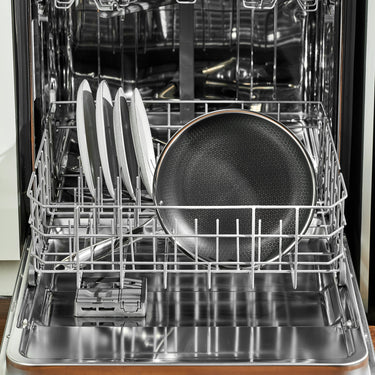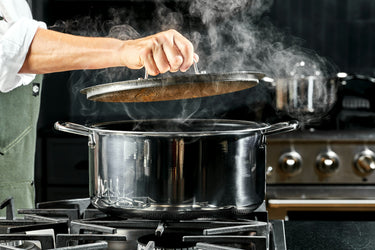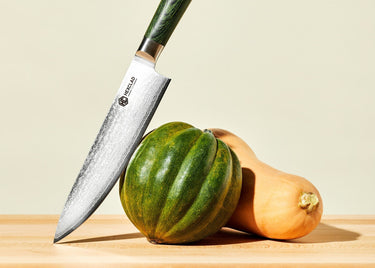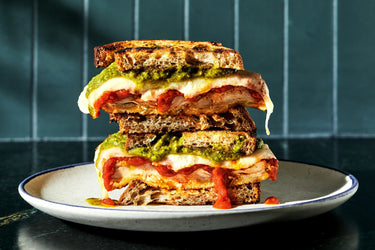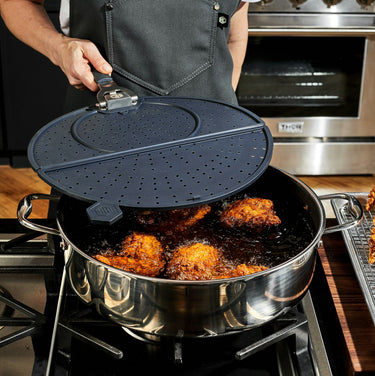The Best Ways To Cook Eggs in a Non-Stick Pan
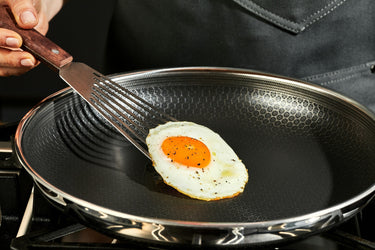
When you think of a classic breakfast, chances are that a few egg dishes will immediately come to mind. Maybe you think of a breakfast sandwich, complete with meat, cheese, and a bagel.
Or maybe your idea of the perfect brunch is something else egg-based. Eggs benedict, made with poached eggs coated in a delectable hollandaise (a sauce that also contains eggs), comes to mind.
If poaching eggs is your goal, we recommend using a high-quality pot instead of a pan. That way, you can quickly get a consistent simmer, and you will have enough space to create a whirlpool in the water. The same goes for if you want to make soft-boiled eggs, medium-boiled eggs, or hard-boiled eggs (like those used for deviled eggs).
With the help of a HexClad Hybrid Pot, you can achieve boiling water in no time. Other than those techniques, though, the vast majority of ways to prepare an egg take place in a capable pan.
Which technique you want to use to cook your eggs will depend on what recipe you’re making or what attributes you want your dish to have. If you want your eggs to have a runny yolk, you will, of course, need to cook them for less time and on lower heat. No matter what.
While many popular egg recipes include a partially liquid yolk, it’s much rarer for an egg white to be served raw on its own. For the purposes of our techniques, if the egg white is separate from the yolk, you will always want it to be fully cooked through.
What Are the Best Ways To Cook Eggs in a Non-Stick Pan?
Eggs are protein-rich, easy to make, and easy to enjoy — but what are the best ways to make your eggs in a non-stick pan? How can you achieve a perfect end result, and what should you keep in mind? Without further ado, here are a few of the most beloved ways to cook eggs with one of the most useful kitchen tools.
1. Fried
Fried eggs are a classic for a reason. They’re quick to make, give you a plethora of different textures to dig into, and can be enjoyed in all sorts of different dishes. In order to make this variation, you can choose to either crack eggs into a small bowl or a ramekin, or you can just crack them and put them right in the pan.
Putting each individual egg in its own bowl first allows you to make sure no shell remains and gives you added control.
Add some of your choice of fat (melted butter, olive oil, vegetable oil, etc.) to the pan, and give it a few minutes to heat over low heat to medium heat. Carefully pour or crack the eggs into the pan, making sure to keep them separate if you’re frying more than one. Once the whites are firm, but the egg yolk is still runny, it’s ready to eat. You can also keep it on the stove for a bit longer or even cover it to allow it to cook further.
2. Sunny Side Up
The method behind making a sunny-side-up egg is quite similar to making a fried egg. Rather than letting the sides brown somewhat as the egg whites solidify, put a lid on the pan when you notice that the sides of the egg have turned white. In about two to two and a half minutes, you’ll have perfectly set egg whites with a deliciously runny yolk.
3. Over Easy
These next three egg cooking techniques are also variations of frying an egg. As opposed to a typical fried egg, over-easy, over-medium, and over-hard eggs are all flipped at some point.
The only difference between the three is how long they are allowed to cook for, and, as a result, how hard their yolks become. Start an over-easy egg in the same way you fry an egg. Once the whites are solid and possibly even browning a bit (depending on how you like them), flip the egg in one smooth motion. In 30 seconds to a minute, your over-easy egg is ready to eat. If you put it in an egg sandwich, get ready for a wonderfully gooey mess.
4. Over Medium
The key to making over-medium eggs is to wait a bit longer after you flip it in the frying pan. You take an over-easy egg off the heat pretty quickly, but give it about one to two minutes for the yolk to solidify slightly more in the hot pan.
5. Over Hard
Over-hard eggs have the longest cook time of the three, but it’s still pretty minimal. After the egg is flipped, wait two to three minutes for the yolk to be fully set.
6. Omelette
Omelettes (or “omelets,” if you’re American) are a fantastic tool to let your creativity shine. You can add all sorts of cheeses, veggies, meats, and more. There are different kinds of omelets that are especially prominent in different parts of the world, but we’ll be focusing on one that is simply folded in half.
To cook an omelet, crack two or three eggs into a bowl and then use a fork or whisk to combine them. Give the pan a few minutes to heat up with your preferred form of fat (not cooking spray) on medium-low heat. Then, pour the egg mixture so that it coats the bottom of the pan.
As the eggs begin to firm up, use a spatula to move the outsides of the omelet inward. Then, guide the raw egg toward the now exposed part of the pan.
When you do this, it lets all of the egg cook through while still maintaining the right shape. After a little over five minutes, the eggs should be mostly cooked, and this is when you add any fillings and then fold the omelet in half over itself. After another minute or so, you’re all done!
7. Scrambled
There are different ways to make scrambled eggs, depending on if you like a runnier texture, prefer more cooked ribbon-like eggs, and more. Whisk eggs together in a bowl outside of the pan until combined. Put fat in the pan, and allow it to heat on medium-low. Once the oil or butter begins to shimmer, pour the eggs in.
If you want a more buttery texture, start moving the eggs around immediately, and don’t stop until they’re cooked through. If you like them more solid, you can move them less often and keep them in the pan for longer.
8. Eggs in a Nest
This is one of the more adorable ways to prepare eggs. With either a knife or a cookie cutter, remove a circle section out of the inside of a piece of bread.
When the fat in the pan is heated, put the bread with the cut-out circle into the pan. Delicately pour a fresh egg into the center of the circle. Once the egg is cooked all the way through on the bottom, flip it over and allow it to finish cooking on both sides.
9. Frittata
For reference, a frittata is essentially a quiche without the crust. Frittatas are typically started on the stovetop and finished in the oven. HexClad pans are oven safe, so you can transfer the dish easily. The exact amount of eggs you’ll use will depend on how many people you’re serving and the size of your pan. Usually, it will be between six and 10.
Add milk and seasonings, and then combine it all. Sautee whichever vegetables you want in the pan, and then add the egg mixture. Make sure that the eggs cover all of the ingredients and coat the pan evenly. Put it into a preheated 400-degree oven, and bake until springy.
Why Is a Non-Stick Pan Best for Eggs?
Now that you know how to prepare different varieties of eggs and how they can enhance your meal, let’s get back to basics. Some of these techniques, especially the simpler ones, might seem like they could be made in any type of pan. However, not all pans are created equal.
Eggs can be notoriously delicate and sticky, so cooking them in anything other than a non-stick pan is a total hassle. Otherwise, you might spend more time washing dishes than you spent cooking the eggs themselves.
Some people like to prepare their eggs in a cast iron skillet, but there is no doubt that cleaning up afterward is less than ideal. Since eggs are so sticky, they can easily form a residue on the bottom of and around the pan. Not only is this a pain when washing up, but it also means that you lose some of the egg in the pan, so there’s less on the plate.
A Perfect Pan for Perfect Eggs
If you still want the benefits of a cast iron pan without having to deal with the difficult cleaning, look no further than an 8” HexClad Hybrid Pan. With all the durability of cast iron, and the heat retention and simplicity of care characteristic of stainless steel, all of our pots and pans are winners.
Add in the fact that they are treated with a non-stick coating, and it just gets better. Gone are the days of slaving away over the sink, trying to get the remnants of egg off of your pan. HexClad’s cookware is dishwasher safe, giving you a seamless experience both during and after cooking.
Sources:
The Health Benefits of Egg Protein | PMC
Why You Should Never Use Cooking Spray on Your Nonstick Pans | Southern Living
What Not To Do When Cooking Eggs: 7 Common Mistakes | The Spruce Eats
